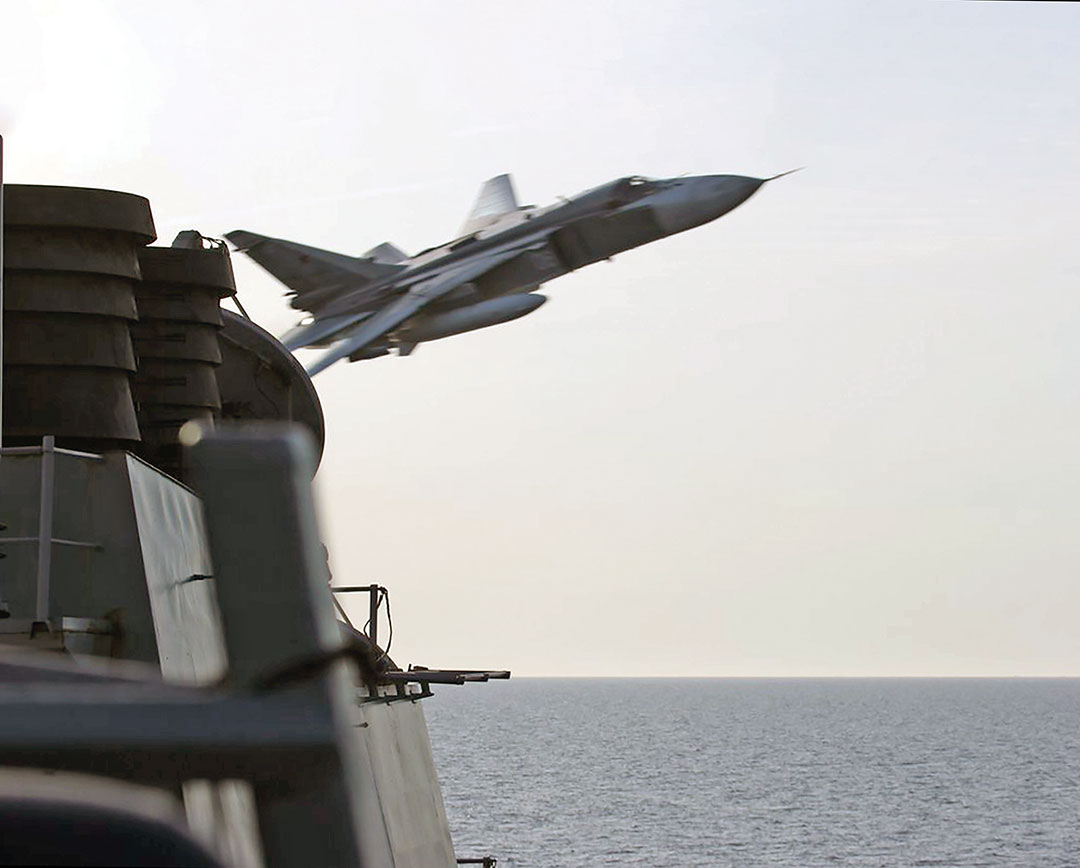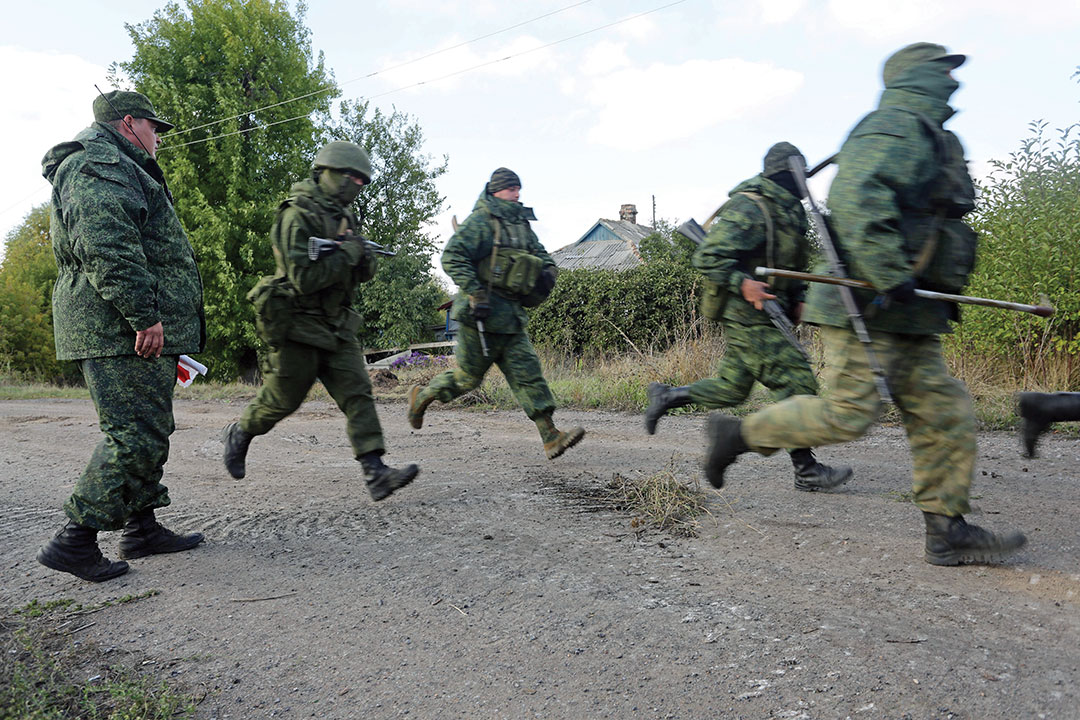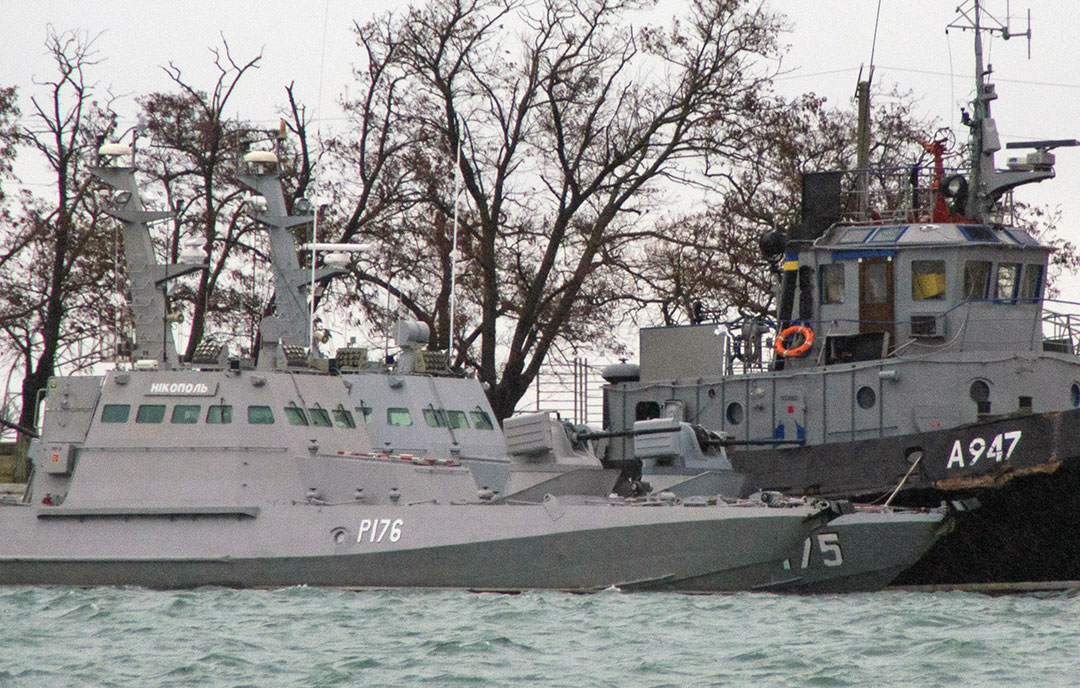Hybrid Warfare in the Legal and Strategic Gray Zone
By Lt. Douglas Cantwell, Judge Advocate General’s Corps, U.S. Navy
The best way to boil a frog, the adage goes, is to turn the heat up slowly enough so the frog does not realize it is being cooked. If the perpetrators hacked the stove’s software, denied their culpability, and bombarded bystanders with fake news before annexing the kitchen, one might have a workable analogy for hybrid warfare.
Alternately termed nonlinear war, active measures or conflict in “the gray zone,” hybrid warfare has no single, agreed upon definition. In the abstract, a state engaging in hybrid warfare foments instability in another state’s domestic affairs, prioritizing nonkinetic military means such as cyber and influence operations in concert with economic pressure, support for local opposition groups, disinformation and criminal activity. It may involve the covert deployment of unmarked troops or irregular combatants, though hybrid warfare’s reliance on cyber capabilities and nonstate proxies is distinctive. The strategic benefit of hybrid warfare is to obscure the involvement of an aggressor state. Even the thinnest veneer of deniability may delay or fragment opposition to actions that otherwise would invite a vocal, sometimes forceful, international response.
Hybrid warfare is most often associated with aggressive Russian foreign policy over the past decade. Russia’s embrace of hybrid warfare has been credited to Valery Gerasimov, chief of the general staff of the Russian armed forces. In 2013, Gerasimov articulated his view of hybrid warfare as an asymmetrical response to the spread of liberal democracy in a globalized world, although Russian writings, including Gerasimov’s, do not actually use the term hybrid warfare but rather “nonlinear” or “new generation” warfare. It is a corollary to Carl von Clauswitz’s conception of war as politics by other means. Gerasimov observed “the role of nonmilitary means of achieving political and strategic goals has grown, and, in many cases, they have exceeded the power of force of weapons in their effectiveness.” Consequently, he advocated the “broad use of political, economic, informational, humanitarian, and other nonmilitary measures — applied in coordination with the protest potential of the population,” to be “supplemented by military means of a concealed character.”

Observers may disagree about which cases should be classified as hybrid war. Russia’s 2008 invasion of Georgia and the resulting de facto annexation of Abkhazia and South Ossetia, its actions in 2014 to seize and annex Crimea, and its deployment of “little green men” leading to the declaration of the Donetsk People’s Republic and Luhansk People’s Republic in eastern Ukraine are the clearest examples of Russian hybrid warfare applied to full effect. However, hybrid war need not result in the annexation of territory. A disinformation campaign fomenting anti-government riots followed by a cyber attack crippling Estonia’s digital infrastructure in 2007, orchestration of elaborate coup attempts in Macedonia in 2016 and Montenegro in 2017, support for right-wing political parties in France and Germany, and interference in the 2016 United States election all fit within Gerasimov’s description of hybrid warfare. Rather than merely a descriptor for isolated cases or a constellation of tactics, hybrid warfare is better understood as a grand strategy aimed at destabilizing the existing liberal order.
Conceptually, framing hybrid warfare as an innovation in international affairs has drawn criticism. All states engage in some forms of covert action and nonmilitary measures constitute essential tools of diplomacy. Additionally, hybrid warfare resembles operations undertaken by both opposing blocs during the height of the Cold War and by many modern states under the heading of irregular warfare. Skeptics have therefore questioned whether, aside from the introduction of cyber capabilities and the name itself, there really is anything novel about hybrid war. States on the front lines facing the particular hybrid threat posed by Russia have answered that question in the affirmative, investing in strategic thinking on how best to counter hybrid warfare techniques. In April 2017, a group of 11 NATO and European Union member states signed a joint memorandum of understanding in Finland, establishing the European Centre of Excellence for Countering Hybrid Threats in Helsinki. The center, inaugurated in October 2017, engages in strategic dialogue, research, training and consultation to illuminate vulnerabilities to hybrid measures and improve resilience against hybrid threats.
Hybrid war under international law
Understanding the relationship between hybrid warfare and international law governing the use of force is central to countering hybrid threats. Hybrid measures have been employed, with increasing success, to undermine existing international protections for the territorial integrity and political independence of states. Foremost is the ban on aggressive war. Hybrid warfare has created a new vehicle for aggression, identified as the “supreme international crime” in 1946 at the International War Crimes Tribunal at Nuremberg. Outlawed by the Kellogg-Briand Pact, enforced during the tribunals at Nuremberg and Tokyo, prohibited in the United Nations Charter, and reaffirmed in the Kampala amendments to the Rome Statute of the International Criminal Court, states endorse with near unanimity the general principle that aggression violates international law.
The rub lies in attempting to define aggression and enforce its prohibition in particular cases. Incorporation of a defined crime of aggression under the jurisdiction of the International Criminal Court represents measured but uncertain progress. Aggression has not been enforced judicially since Nuremberg. States continue to disagree about the definition of aggression and powerful states that are not party to the Rome Statute — including the U.S., India, China and Russia — have not committed to the particular definition codified in the amendments. However, states, both unilaterally and multilaterally, have acted to counter aggression. Formation of an international coalition to expel Saddam Hussein’s forces from Kuwait in 1990-91 stands as the high-water mark of marshaling collective will to forcefully counter aggression. But modern cases of aggression rarely involve a blitzkrieg of tanks and uniformed forces rolling across an international border to take a neighboring state’s capital. Few have drawn such a swift and forceful response as Operation Desert Shield and Operation Desert Storm. In cases where an act of aggression may be less immediately apparent or where the status of either the victim or aggressor state discourages a forceful response, nonforceful measures such as economic sanctions, diplomatic censure and verbal condemnation may be employed. Such was the case following Russia’s actions in Georgia and later in Crimea and eastern Ukraine. That there was widespread international condemnation of Russia bolsters the general prohibition against aggression. That the international response has not resulted in a return to the status quo places Russia’s actions in Georgia and Ukraine among a handful of instances where a state has redrawn post-1945 borders with force, not simply occupying but annexing territory. As such, it is important to situate hybrid measures within the existing law they seek to circumvent.

The U.N. Charter prohibits aggression through its ban on uses of force without legal justification. Article 2(4) guarantees the right of states to be free from any threat or use of force against their territorial integrity or political independence. Prohibited uses of force encompass, but need not reach, the level of an armed attack, the basis for self-defense under Article 51 of the U.N. Charter (as well as the collective defense provision contained in Article 5 of the Washington Treaty of 1949 establishing NATO).
Unlawful uses of force that violate Article 2(4) generally require forces engaging in military activities, whether traditional armed forces and nonstate armed groups, as detailed in International Court of Justice (ICJ) rulings, including a 1986 decision regarding U.S. actions in Nicaragua and a 2005 decision regarding Uganda’s actions in the Democratic Republic of the Congo. This framework has proven capable of accounting for changes in the means through which states wage war. For example, in the context of cyber operations, the Tallinn Manual, a treatise on the application of existing international law to cyber space drafted by an international group of experts, affirms that cyber operations may constitute unlawful uses of force if they are attributed to the armed forces of a state or if their effects mimic those of traditional military operations. In theory then, the U.N. Charter’s prohibition on the use of force is sufficient to account for hybrid threats when they resemble traditional military activities — for example, when unmarked troops engage in hostilities — but also when a state employs cyber capabilities in a hybrid war campaign to damage or disable infrastructure in a way that resembles the use of bombs and bullets.

In practice, hybrid measures are designed to avoid being identified as clear violations of the Charter, even when they do constitute an unlawful use of force. One way this is achieved is through an emphasis on covert action. States have long engaged in covert operations that may run afoul of Article 2(4)’s prohibition on nonintervention, as Alexandra H. Perina argues in a 2015 article in the Columbia Journal of Transnational Law. While reasons for engaging in covert action vary and are often mixed, uses of force may be done covertly at least in part to honor international law in the breach. Maintaining public deniability limits the establishment of opinio juris for acts that blatantly violate the charter — important for maintaining an international system that has prevented major power war since 1945. In the context of hybrid warfare, such benevolent motivations should not be assumed. Covert means are crucial to a hybrid warfare strategy not because covert actions may discourage open violations of the charter by others, but because it exploits the weakness of an international enforcement regime where the status quo is often inaction, particularly in those cases where aggressor states have sown doubt as to attribution or the legality of their behavior.
Other hybrid measures are simply not accounted for by the charter’s prohibition on the use of force. For example, economic measures traditionally do not violate Article 2(4). Disinformation and criminal activity generally also fall below this threshold. However, actions not constituting use of force may still be unlawful as a form of interference. Sovereign noninterference is implicit in the doctrine of sovereign equality, enshrined in Article 2(1) of the charter. The U.N. General Assembly has opined on the concept. In a 1965 declaration, the assembly described interference as “the subordination of the exercise of [a state’s] sovereign rights” up to and including the violent overthrow of a state’s government. In a 1970 declaration, the assembly highlighted the ban on intervention in the internal or external affairs of any other state along with “all other forms of interference or attempted threats against the personality of the State or against its political, economic and cultural elements.”
Interference may be understood as a lesser-included offense of intervention. The controlling expression is contained in the ICJ landmark 1986 Nicaragua decision. In Nicaragua, the court emphasized the right of all states to decide issues inherent to state sovereignty, to include a state’s political, economic, social and cultural system and the formulation of its foreign policy. When those choices are influenced by methods of coercion, including through subversion or indirect force, that constitutes unlawful interference.

The charter framework, therefore, is at least conceptually sufficient to address hybrid measures short of the use of force. However, as Tom J. Farar wrote in a 1985 paper for the American Journal of International Law, since Nicaragua the contours of what constitutes coercive interference have remained murky. Lack of clarity and a threshold that has placed interference nearly on par with intervention have left gaps that hybrid measures may exploit. No single element of a hybrid campaign may present a clear case of coercive interference when viewed in isolation. However, constant, coordinated interference intended to destabilize a government may violate the spirit, if not the letter, of the charter’s protections for the political independence of states. While a state with robust civic institutions may be able to withstand a trumpet blast of false news stories, riots and strategic leaks of information intended to undermine elections, smaller states in particular may find themselves overwhelmed. As such, it is important that coercive acts be recognized, scrutinized, and subject to a swift and coordinated response where necessary by those states and international and nongovernmental institutions seeking to uphold protections on political independence enshrined in the charter. Likewise, coercive acts must be distinguished from actions taken transparently and lawfully by states, which may exert diplomatic pressure without it constituting illegal interference.
Conclusion
A complete understanding of hybrid war as a strategic concept requires that it be properly situated within the existing regime governing the use of force under international law. Addressing legal aspects of hybrid conflict in turn requires proper acknowledgment of hybrid campaigns that amount to aggression and more robust theorizing on what hybrid measures constitute coercive interference. In that sense, efforts such as the establishment of the European Centre of Excellence for Countering Hybrid Threats are a welcome development. Its supporters should ensure that the growing body of work around hybrid warfare incorporates the established lexicon of international law, an important step toward clearing the fog of war in the gray zone.


Comments are closed.